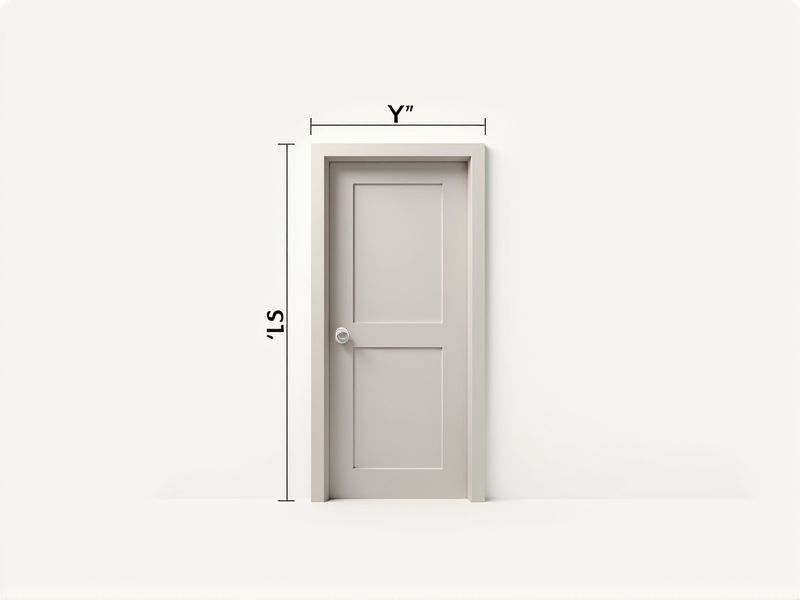
When selecting a pantry door, it's important to know the standard dimensions to ensure a proper fit. Most pantry doors are typically 24, 28, 30, or 32 inches wide, with a standard height of 80 inches. However, smaller pantries in tight spaces may use a 24-inch width, while larger openings might need customized solutions. Always measure your specific pantry opening before purchasing a door to ensure a seamless installation and optimal functionality in your space.
Width: 24 To 36 Inches
The standard width for pantry doors ranges from 24 to 36 inches, accommodating various kitchen layouts and personal preferences. A 24-inch door is ideal for smaller spaces, ensuring efficient access without overwhelming the area. For a more spacious approach, a 36-inch door enhances accessibility and provides ease of movement for large items. Selecting the appropriate width can significantly impact both functionality and aesthetic appeal in your kitchen design.
Height: 80 Inches
The standard height for a pantry door is 80 inches, providing ample clearance for most storage needs and accessibility. This height is designed to accommodate average ceiling heights, ensuring the door seamlessly integrates into various kitchen layouts. A door of this size can enhance the aesthetic appeal of your pantry while allowing easy access to your ingredients and cooking supplies. For optimal functionality, consider choosing a door material that complements your kitchen decor and enhances durability.
Thickness: 1.25 To 1.75 Inches
The standard thickness for pantry doors typically ranges from 1.25 to 1.75 inches, ensuring durability and stability. A thicker door provides enhanced insulation and minimizes sound transmission, making it an ideal choice for maintaining a quiet kitchen environment. With a variety of styles available, you can select a pantry door that complements your home decor while adhering to these thickness guidelines. When considering your options, remember that a solid core door within this thickness range offers superior performance and longevity.
Swing: In-Swing/Out-Swing Options
The standard pantry door typically features swing options that include both in-swing and out-swing designs, allowing for versatility in small spaces. An in-swing pantry door, which opens inward, can optimize your kitchen layout by conserving exterior space, making it ideal for tighter areas. Conversely, an out-swing door provides easier access to the pantry's contents while keeping the kitchen floor clear, beneficial for homes with frequent foot traffic. When planning your pantry, consider the swing direction that complements your kitchen's design and maximizes functionality.
Sliding Or Hinged Style
A sliding pantry door typically requires less space and can enhance accessibility, making it ideal for narrow kitchens. In contrast, hinged doors may offer a more traditional aesthetic and allow for a wider opening, accommodating larger items. Depending on your kitchen layout, sliding doors can be an excellent choice if you have limited square footage, while hinged doors can complement a spacious design. Consider factors such as your total kitchen area, the frequency of use, and stylistic preferences when choosing between these two options.
Material: Wood, Metal, Glass
Pantry doors made from wood offer a classic and warm aesthetic, ideal for traditional or rustic kitchens, with options like oak, maple, or cherry showcasing rich textures. Metal pantry doors provide a sleek, modern look, commonly available in stainless steel or aluminum, perfect for contemporary designs and durability. Glass pantry doors create an elegant, airy feel, allowing for visibility while keeping contents organized, often framed in wood or metal for added support. Consider the maintenance and insulation properties of each material to suit your kitchen's functional needs and style preferences.
Pre-Hung Or Slab Type
When selecting a pantry door, consider the advantages of pre-hung versus slab types. Pre-hung doors come fully assembled with a door frame, ensuring easy installation and immediate use, while slab doors offer flexibility and customization for an existing frame. Standard dimensions for pre-hung options typically range from 28 to 36 inches in width, while slab doors can vary greatly, allowing for creative designs or modifications. Choose based on your kitchen layout, desired aesthetic, and whether you prefer a straightforward installation process or the adaptability of a slab door.
Custom Sizing Options Available
Customized pantry doors offer precise sizing to fit any kitchen layout, ensuring a seamless integration into your space. With options ranging from standard dimensions to bespoke measurements, you can achieve a tailored look that enhances your home's aesthetics. Many manufacturers provide a variety of materials, such as wood, glass, and metal, allowing you to select a finish that complements your interior design. Investing in custom pantry doors can elevate functionality while maximizing storage efficiency, providing a stylish solution to your organizational needs.
Door Frame Compatibility
A standard pantry door typically measures 24 to 36 inches in width, making it essential for ensuring compatibility with various door frame sizes. Door frames usually have a height of 80 inches, accommodating most standard doors; however, modifications may be necessary for non-standard spaces. When selecting a pantry door, consider the material of the door frame, as wood or metal frames can affect installation techniques and durability. Proper compatibility not only enhances aesthetic appeal but also ensures smooth operation and optimal functionality.
Handle And Lock Placement
The standard pantry door typically features handles positioned at an ergonomic height of 36 to 48 inches above the floor, ensuring easy access for users of various heights. Locks, when included, are generally installed around 54 inches from the ground, providing security while remaining easy to operate. In most designs, the handle is placed 2 to 5 inches away from the edge of the door, allowing for comfortable gripping and minimizing the risk of pinch points. Your choice of handle type, whether a pull or lever style, can influence both aesthetics and functionality, enhancing your kitchen's overall design.
